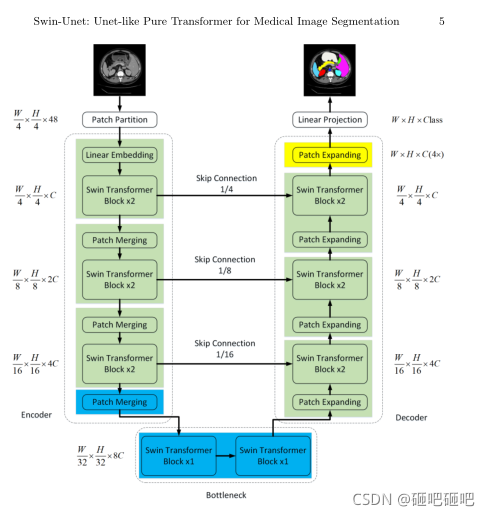
?model流程学习:?
self.swin_unet = SwinTransformerSys(img_size=config.DATA.IMG_SIZE,
patch_size=config.MODEL.SWIN.PATCH_SIZE,
in_chans=config.MODEL.SWIN.IN_CHANS,
num_classes=self.num_classes,
embed_dim=config.MODEL.SWIN.EMBED_DIM,
depths=config.MODEL.SWIN.DEPTHS,
num_heads=config.MODEL.SWIN.NUM_HEADS,
window_size=config.MODEL.SWIN.WINDOW_SIZE,
mlp_ratio=config.MODEL.SWIN.MLP_RATIO,
qkv_bias=config.MODEL.SWIN.QKV_BIAS,
qk_scale=config.MODEL.SWIN.QK_SCALE,
drop_rate=config.MODEL.DROP_RATE,
drop_path_rate=config.MODEL.DROP_PATH_RATE,
ape=config.MODEL.SWIN.APE,
patch_norm=config.MODEL.SWIN.PATCH_NORM,
use_checkpoint=config.TRAIN.USE_CHECKPOINT)图片大小设置为224*224*3(输入图片为3通道的),patch_size:4,num_class:21843(类别数量),embed_dim:线性投影输出通道数
Swin Transformer
参数设置
def __init__(self, img_size=224, patch_size=4, in_chans=3, num_classes=1000,
embed_dim=96, depths=[2, 2, 2, 2], depths_decoder=[1, 2, 2, 2], num_heads=
[3, 6, 12, 24],window_size=7, mlp_ratio=4., qkv_bias=True, qk_scale=None,
drop_rate=0., attn_drop_rate=0., drop_path_rate=0.1,
norm_layer=nn.LayerNorm, ape=False, patch_norm=True,
use_checkpoint=False, final_upsample="expand_first", **kwargs):参数解释:
Patch Embedding
划分patch:模型先将图像分割成每块大小为 4x4的patch,那么就会有56x56个patch。--patchEmbed。
编码初始特征:conv卷积(3,96,4,4),经过norm后56x56x96。
# 将图片分割为不重叠的面片
self.patch_embed = PatchEmbed(
img_size=img_size, patch_size=patch_size, in_chans=in_chans, embed_dim=embed_dim,
norm_layer=norm_layer if self.patch_norm else None)
num_patches = self.patch_embed.num_patches
patches_resolution = self.patch_embed.patches_resolution
self.patches_resolution = patches_resolutionAttention:预处理完成后,维度是H/4XW/4XC。
BasicLayer:
PatchMerging:downsample
?每个block是W-MSA(window-multihead self attention)或者SW-MSA(shift window multihead self attention),一般有偶数个block,两种block交替出现,比如6个block,0,2,4是W-MSA,1,3,5是SW-MSA。在经历完一个stage后,会进行下采样,依旧是56*56
class PatchMerging(nn.Module):
r""" Patch Merging Layer.
Args:
input_resolution (tuple[int]): Resolution of input feature.
dim (int): Number of input channels.
norm_layer (nn.Module, optional): Normalization layer. Default: nn.LayerNorm
"""
def __init__(self, input_resolution, dim, norm_layer=nn.LayerNorm):
super().__init__()
self.input_resolution = input_resolution
self.dim = dim
self.reduction = nn.Linear(4 * dim, 2 * dim, bias=False)
self.norm = norm_layer(4 * dim)
def forward(self, x):
"""
x: B, H*W, C
"""
H, W = self.input_resolution
B, L, C = x.shape
assert L == H * W, "input feature has wrong size"
assert H % 2 == 0 and W % 2 == 0, f"x size ({H}*{W}) are not even."
x = x.view(B, H, W, C)
x0 = x[:, 0::2, 0::2, :] # B H/2 W/2 C
x1 = x[:, 1::2, 0::2, :] # B H/2 W/2 C
x2 = x[:, 0::2, 1::2, :] # B H/2 W/2 C
x3 = x[:, 1::2, 1::2, :] # B H/2 W/2 C
x = torch.cat([x0, x1, x2, x3], -1) # B H/2 W/2 4*C
x = x.view(B, -1, 4 * C) # B H/2*W/2 4*C
x = self.norm(x)
x = self.reduction(x)
return x个patch,四个为一组,分别取每组中的左上,右上、左下、右下堆叠一起,经过一个layernorm,linear层,实现维度下采样、特征加倍的效果。实际上它可以看成一种加权池化的过程.--进行四次下采样。
?SwinTransformerBlock:
shift_size<windowsize<imput_resolution
windowattention:
class WindowAttention(nn.Module):
def __init__(self, dim, window_size, num_heads, qkv_bias=True, qk_scale=None, attn_drop=0., proj_drop=0.):
super().__init__()
self.dim = dim
self.window_size = window_size # Wh, Ww
self.num_heads = num_heads
head_dim = dim // num_heads
self.scale = qk_scale or head_dim ** -0.5
# define a parameter table of relative position bias
self.relative_position_bias_table = nn.Parameter(
torch.zeros((2 * window_size[0] - 1) * (2 * window_size[1] - 1), num_heads)) # 2*Wh-1 * 2*Ww-1, nH
# get pair-wise relative position index for each token inside the window
coords_h = torch.arange(self.window_size[0])
coords_w = torch.arange(self.window_size[1])
coords = torch.stack(torch.meshgrid([coords_h, coords_w])) # 2, Wh, Ww
coords_flatten = torch.flatten(coords, 1) # 2, Wh*Ww
relative_coords = coords_flatten[:, :, None] - coords_flatten[:, None, :] # 2, Wh*Ww, Wh*Ww
relative_coords = relative_coords.permute(1, 2, 0).contiguous() # Wh*Ww, Wh*Ww, 2
relative_coords[:, :, 0] += self.window_size[0] - 1 # shift to start from 0
relative_coords[:, :, 1] += self.window_size[1] - 1
relative_coords[:, :, 0] *= 2 * self.window_size[1] - 1
relative_position_index = relative_coords.sum(-1) # Wh*Ww, Wh*Ww
self.register_buffer("relative_position_index", relative_position_index)
self.qkv = nn.Linear(dim, dim * 3, bias=qkv_bias)
self.attn_drop = nn.Dropout(attn_drop)
self.proj = nn.Linear(dim, dim)
self.proj_drop = nn.Dropout(proj_drop)
trunc_normal_(self.relative_position_bias_table, std=.02)
self.softmax = nn.Softmax(dim=-1)
def forward(self, x, mask=None):
"""
Args:
x: input features with shape of (num_windows*B, N, C)
mask: (0/-inf) mask with shape of (num_windows, Wh*Ww, Wh*Ww) or None
"""
B_, N, C = x.shape
qkv = self.qkv(x).reshape(B_, N, 3, self.num_heads, C // self.num_heads).permute(2, 0, 3, 1, 4)
q, k, v = qkv[0], qkv[1], qkv[2] # make torchscript happy (cannot use tensor as tuple)
q = q * self.scale
attn = (q @ k.transpose(-2, -1))
relative_position_bias = self.relative_position_bias_table[self.relative_position_index.view(-1)].view(
self.window_size[0] * self.window_size[1], self.window_size[0] * self.window_size[1], -1) # Wh*Ww,Wh*Ww,nH
relative_position_bias = relative_position_bias.permute(2, 0, 1).contiguous() # nH, Wh*Ww, Wh*Ww
attn = attn + relative_position_bias.unsqueeze(0)
if mask is not None:
nW = mask.shape[0]
attn = attn.view(B_ // nW, nW, self.num_heads, N, N) + mask.unsqueeze(1).unsqueeze(0)
attn = attn.view(-1, self.num_heads, N, N)
attn = self.softmax(attn)
else:
attn = self.softmax(attn)
attn = self.attn_drop(attn)
x = (attn @ v).transpose(1, 2).reshape(B_, N, C)
x = self.proj(x)
x = self.proj_drop(x)
return x